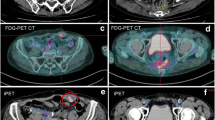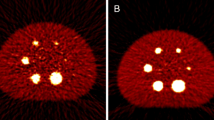Abstract
Technetium-99m (Tc-99m) is an ideal radionuclide for clinical use. A murine monoclonal antibody (Mab) designated F33-104 binds to specific parts of carcinoembryonic antigen (CEA). In the present study, intact Mab F33-104 was labeled with Tc-99m, and the immunoreactivity and biodistribution of Tc-99m-labeled F33-104 were studied in athymic nude mice bearing human colorectal cancer xenografts. Mab F33-104, reduced under optimal conditions, was quickly and stably tagged with Tc-99m without loss of immunoreactivity. Higher tumor uptake of Tc-99m-labeled F33-104 was noted in the biodistribution, resulting in a higher localization index and specific-to-non-specific tumor ratio than those of radioiodinated F33-104. These results suggest the potential of Tc-99m-labeled Mab F33-104 for the radioimmunoimaging of colorectal cancer.
Similar content being viewed by others
Abbreviations
- CEA:
-
carcinoembryonic antigen
- Tc-99m:
-
technetium-99m
- I-125:
-
iodine-125
- Mab:
-
monoclonal antibody
- 2-ME:
-
2-mercaptoethanol
- HMDP:
-
hydroxyl methylene diphosphonate
- In-111:
-
indium-111
- PBS:
-
phosphate buffered saline
- hCG:
-
human chorionic gonadotropin
- RIA:
-
radioimmunoassay
References
Gold P, Freedman SO. Demonstration of tumor specific antigens in human colonic carcinomata by immunological tolerance and absorption techniques.J Exp Med 121: 439–471, 1965.
National Institutes of Health Consensus Development Conference Statement. Carcinoembryonic antigen: its role as a marker in the management of cancer.Cancer Res 41: 2017–2018, 1981.
Begent RHJ. Recent advances in tumor imaging use of radiolabelled anti tumor antibodies.Biochimi Biophys Acta 780: 151–166, 1985.
Goldenberg DM. Current status of cancer imaging with radiolabeled antibodies.J Cancer Res Clin Oncol 113: 203–208, 1987.
Hnatowich DJ. Recent developments in the radiolabeling of antibodies with iodine, indium, and technetium.Semin Nucl Med 20: 80–91, 1990.
Goldenberg DM. Cancer imaging with CEA antibodies: historical and current perspectives.Int J Bio Markers 7: 183–188, 1992.
Shimura N, Kojima S, Kubodera A, Kubota K, Takahashi T, Oyamada H. Radioimmunodetection of human colon cancer using Tc-99m-MDP-MoAb-A7 in mice. (letter)Int J Rad Appl Instrum B 19: 105–109, 1992.
Kuroki M, Haruno M, Murakami M, Wakisaka M, Oikawa S, Nakazato H, et al. Epitope mapping of the nonspecific cross-reacting antigen using various related recombinant proteins expressed in Chinese hamster ovary cells and eight distinct monoclonal antibodies.Immunol Invest 21: 143–158, 1992.
Kuroki M, Murakami M, Wakisaka M, Krop WA, Oikawa S, Nakazato H, et al. Epitopes predominantly retained on the carcinoembryonic antigen molecules in plasma of patients with malignant tumors but not on those in plasma of normal individuals.Jpn J Cancer Res 83: 505–514, 1992.
Kohno K, Nakata K, Kusumoto Y, Ishii N, Kohji T, Matsuoka Y, et al. Variations in radioimmunoscintigraphic detection of tumor showed by five monoclonal antibodies to carcinoembryonic antigen.Ann Nucl Med 5: 69–75, 1991.
Mather SJ, Ellison D. Reduction-mediated technetium-99m labeling of monoclonal antibodies.J Nucl Med 31: 692–697, 1990.
Baum RP, Hertel A, Lorenz M, Schwarz A, Encke A, Hor G. Tc-99m-labeled anti-CEA monoclonal antibody for tumour immunoscintigraphy: first clinical results.Nucl Med Commun 10: 345–352, 1989.
Hunter WM, Greenwood FC. Preparation of iodine-131 labeled growth hormone of high specific activity.Nature 194: 495–496, 1962.
Moshakis V, Mcllhinney RA, Raghavan D, Neville AM. Localization of human tumor xenografts after iv administration of radiolabeled monoclonal antibodies.Br J Cancer 44: 91–99, 1981.
Beaumier PL, Krohn SA, Carrasquillo JA, Eary J, Hellstrom I, Hellstrom KE, et al. Melanoma localization in nude mice with monoclonal Fab against p97.J Nucl Med 26: 1172–1179, 1985.
Mach JP, Chatal JF, Lumbroso JD, Buchegger F, Forni M, Ritschard J, et al. Tumor localization in patients by radiolabeled monoclonal antibodies against colon carcinoma.Cancer Res 43: 5593–5600, 1983.
Sakahara H, Endo K, Nakashima T, Koizumi M, Kunimatsu M, Kawamura Y, et al. Localization of human osteogenic sarcoma xenografts in nude mice by a monoclonal antibody labeled with radioiodine and indium-111.J Nucl Med 28: 342–348, 1987.
Zimmer AM, Kazikiewicz JM, Rosen S, Spies SM. Pharmacokinetics of Tc-99m(Sn) and I-131-labeled anticarcinoembryonic antigen monoclonal antibody fragments in nude mice.Cancer Res 47: 1691–1694, 1987.
Yokoyama K, Carrasquillo JA, Chang AE, Colcher D, Roselli M, Sugarbaker P, et al. Differences in biodistribution of indium-111 and iodine-131-Iabeled B72.3 monoclonal antibodies in patients with colorectal cancer.J Nucl Med 30: 320–327, 1989.
Roselli M, Schlom J, Gansow OA, Raubitschek A, Mirzadeh S, Brechbiel MW, et al. Comparative biodistribution of yttrium and indium-labeled monoclonal B72.3 antibody in athymic mice bearing human colon carcinoma xenografts.J Nucl Med 30: 672–682, 1989.
Nakamura K, Ruiz JA, Kubo A, Hashimoto S. Evaluation of the 111 In-(Sn)-citrate method to label antibodies for radioimmunotargeting studies.Int J Rad Appl Instrum B 19: 21–25, 1992.
Saleh MN, Wheeler RH, Lee JY, Khazaeli MB, Unger MW, Russell CH, et al. In-111 labeled monoclonal anticarcinoembryonic antigen antibody (ZCE025) in the immunoscintigraphic imaging of metastatic antigenproducing adenocarcinomas.Clin Nucl Med 16: 110–116, 1991.
Maxon HR III, Schroder LE, Thomas SR, Hertzberg VS, Deutsch EA, Scher HI, et al. Re-186(Sn) HEDP for treatment of painful osseous metastases: initial clinical experience in 20 patients with hormon resistant prostate cancer.Radiology 176: 155–159, 1990.
Eary JF, Durack L, Williams D, Vanderheyden JL. Considerations for imaging Re-188 and Re-186-isotopes.Clin Nucl Med 15: 911–916, 1990.
Author information
Authors and Affiliations
Rights and permissions
About this article
Cite this article
Watanabe, N., Oriuchi, N., Sugiyama, S. et al. Radioimmunoscintigraphy of colorectal cancer with technetium-99m-labeled murine anti-carcinoembryonic antigen monoclonal antibody in athymic nude mice. Ann Nucl Med 8, 23–30 (1994). https://doi.org/10.1007/BF03164983
Received:
Accepted:
Issue Date:
DOI: https://doi.org/10.1007/BF03164983




